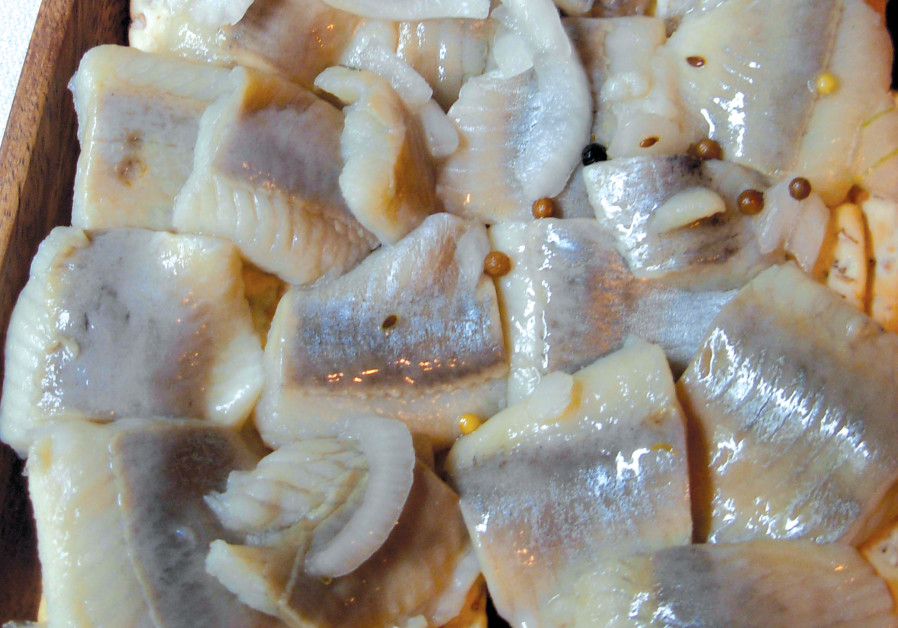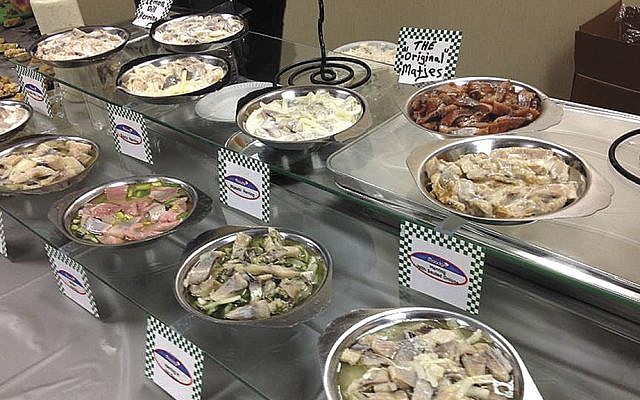These guys have great herring !!!!!!!!!!!!!
 By Elizabeth Kratz | February 27, 2019
By Elizabeth Kratz | February 27, 2019
Naftali and Remi Engel display The Rebbe’s Choice herring at Kosherfest.
How Naftali Engel is making herring ‘hipster’ again.
You never know when something heimish, something many Jews may associate with old-fashioned, staid Jewish fare, like herring and crackers, will somehow turn high-end and hipster. One millenial, barely out of his teens, is putting herring out there for all the internet to see. And he’s got a heck of a story to tell. Herring, get ready: it’s time for your Instagram shoot.
It all started in late 2014, when Queens, New York, teen Naftali Engel was in Israel for post-high school gap year study. He spent some Shabbatot away from his Judean Hills yeshiva with his brother who lives in Tzfat, the “holy city” famous for its more chassidic or kabbalah influenced-artists colonies and spiritually creative enclaves. One Shabbat, Engel tasted a particularly delicious homemade herring, and, perhaps nonchalantly, asked the maker for his recipe. The answer he got was not quite traditional.
Engel’s version of what he heard from this unusual pescaphile was something like the following: “‘First, you have to dance with the fish; then say Tikkun Haklali (a traditional Breslov set of psalms geared toward repentance) with the fish, after that sit down and say some Shemios Hatzadikim (names of the righteous) to the herring. If you can, go to the mikvah before you prepare the fish…,’ it went on like this,” Engel told The Jewish Link.
“I mean, the herring tasted really good, but this was an interesting method to say the least. The man continued, ‘When you spice the fish, make sure to have the proper kavana (intentions). After you finish making it make sure to learn with the herring, and say Tehillim for it,’” Engel recalled.
At that point, Engel gave up on getting an actual recipe out of the man, but succeeded in getting a basic herring recipe from his brother Menachem. “Although I altered the original recipe I was given a bit, it came out great. But what this man gave me was an idea: That I could take the herring and spice it based on what inspires me.”
A business is born
Five years later, Engel is 22 and a busy entrepreneur distributing his own original herrings nationwide, all inspired by that single interaction. From Vietnamese sriracha to smoked Hungarian paprika to Israeli za’atar, Engel has fused spices from his millennial-modern kitchen with that most heimishe, modest fish, bringing new life to that old boring herring.
And millennials seem to intrinsically know a thing or two about branding. In what has seemed like a blink of an eye, a community of 800 enthusiastic followers have popped up on Instagram and are even buying products emblazoned with The Rebbe’s Choice catchphrase—“Heimish meets high end”—and “the rebbe” from the label, who happens to look quite a bit like Engel’s new father-in-law.
‘Making herring on the mirpeset’
But back to 2014. How did this business get started? Engel’s first culinary effort, a jalepeño matjes (matjes is a younger, fattier herring perfect for pickling), made on Engel’s dormitory mirpeset (porch) at Yeshivat Ohr Yerushalayim, were met with clamors for more from his friends. Soon, students from other yeshivot, and their rabbeim, heard about it. “I would make herring for Shabbat and ask if people wanted it, and soon I was selling it out of my dorm room,” he explained.
“My herring started to become well known in the American yeshivas in Jerusalem. Everyone knew about it. By the next summer, I had a name, The Rebbe’s Choice,” and while he was home in the States he hired a graphic designer on Fiverr to illustrate “The Rebbe” who adorns his labels, wearing a fur shtreimel, smiling and holding a whole fish.
“I sold my labeled products in Israel to friends the next year.” Returning home to Queens in 2016 after a year and a half in yeshiva, his began his business in earnest; manufacturing his unique herring recipes out of his shul’s basement in Kew Gardens Hills, Queens; his product had been certified kosher by the O-K.
Fast forward to today: Engel’s herrings are distributed nationwide by Quality Frozen Foods, a large kosher foods distributor; over 1,500 units of herring are produced every week and it’s available in kosher supermarkets in communities nationwide. Engel explained that while he has no prior background in the food industry, he comes from a family full of entrepreneurs, all of whom have found new ways to present items to the public. His grandfather, Engel related, sold postal products, and was apparently the first to sell envelopes in packages of multiples. His father and brother had launched their own pet supply businesses. Engel’s new wife, Remi, also helps him in the business, bringing with her design ideas and her own millennial flair, even launching the hashtag #womenwhoherring.
But who are ‘The Rebbes’ in
‘The Rebbe’s Choice’ herrings?
Millennial marketing aside, what truly sets Engel’s herrings apart (there are currently six, and a seventh one will be released soon) is that the flavorful, modern fusion-cuisine-take-on-classic-flavors are made from recipes using all kinds of sweet and savory spices, sauces and herbs and are all inspired by a Chassidic “Rebbe,” the teachings of whom Engel has learned. A story about each rebbe and how he inspired Engel adorns each box of herring. For example, The Rebbe’s Choice’s sweet black pepper herring is inspired by Reb Levi Yitzchok of Berditchev, who went to tremendous lengths and had great enthusiasm toward finding the good in people, no matter how evil or criminal they were. “Rabbi Levi’s fresh perspective and ardor are the inspiration for this savory and deeply flavored herring,” Engel writes on the label.
In addition to Reb Levi, Engel has so far singled out rebbes from Lelov, Kotzk, Rimanov, and Ropshitz and has written inspirational vignettes about their teachings and why they inspired a particular flavor. Future plans for The Rebbe’s Choice include two types of high-quality smoked salmon, plain and with pastrami flavoring, which is coming out imminently, and a line of flatbread kichel, inspired by the Hungarian Kerister Rebbe, a rabbi from the Tokay region of Hungary known for his incredible hospitality toward strangers. The kichel is not dipped in sugar like the kichel many Americans know, but it is savory and cracker-like and more typical of old Europe. It’s meant to be eaten along with herring, of course. Engel reported he had recently returned from Budapest where he drove multiple hours to visit the kever (grave) of Reb Shayale of Keristir to gain inspiration for the kichel.
But it’s not all about inspiration; Engel is serious about business as well. He and his production team, which includes one full-time manager and several part-timers, take pride in a set of common sense principles for food safety and sustainability. All their herrings are made from Atlantic herring,
primarily matjes, sourced from the Atlantic Ocean from either Europe or Canada, and are bought from fisheries that practice sustainable practices, so that ocean dwellers other than herring aren’t caught in the nets and the supply isn’t depleted. Engel said he benefited from studying for his ServSafe NYC food safety handler licenses; finding them instructive toward making safer choices regarding fresh ingredients and preparation methods. “Stored properly, our cured and pickled herrings are good for six weeks, as per the label on the package. You can tell our herring is fresh by how firm it is. Herring that is soft or mushy is usually frozen whereas our product is fresh,” he explained.
Competitors eyeing the success of Engel’s unique branding have already begun making attempts at copying the products of this quick-growing company, but Engel took this gesture of his competition in stride, and even with some cheer. “Imitation is the sincerest form of flattery, and if I made big enough waves that the largest fish and appetizing companies want to copy me, I know I’m doing something right.” But it’s likely any impersonator can’t hope to match up, because the inspiration and success of the entire brand is very clearly rooted in and growing from Engel’s personal interests and experiences.
All of The Rebbe’s Choice 12-ounce boxes of herring are hand packaged out of its 1,000-square-foot facility in Long Island City. They are made without artificial ingredients or color, and several of the herrings are made without sugar in order to be suitable for those following diabetic diets. All herrings are gluten-free and several contain sesame or egg ingredients, but are clearly marked. The products are now available in select locations in Los Angeles, Glendale (Colorado), Minneapolis, Dallas, Southfield (Michigan), Cleveland Heights (Ohio), Atlanta, Evanston (Illinois), Boston and several cities in Florida. Since 2018, they have become widely available in kosher stores and supermarkets with kosher sections all over New York, New Jersey and Connecticut, including many ShopRite stores. Don’t forget to follow Engel’s ever-inspiring and amusing stories on Instagram, Facebook or Twitter at @therebbeschoice.
source:https://www.jewishlinknj.com/food/29909-dancing-with-the-fishes




